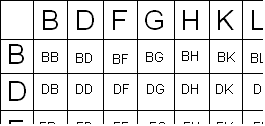| After 2 years of working on my first conlang, I was getting frustrated over the process of word making. I would find myself poring over foreign language dictionary in order to get the inspiration to create a good sounding word.
I know there may be computer programs out there that can randomly generate words for you. But if youíre willing to try anything to expand the vocabulary of your conlang, try this and see if you like it. First off : Identify the following properties you want for the morphemes (root words) of your conlang. As in : What order of consonants & vowels do you want for your conlang (phonological constraints) How long do you want a root to be? Do you want vowel or consonant clusters? ECT... For my conlang, I came up with the patterns on the left [( C ) = consonant (V) = vowel] 2 being the smallest, & 4 being the largest Now, arrange your vowels and consonants as you would a multiplication table and "multiply them, as below (Small examples) My conlang has a total of 5 vowels & 15 consonants. Using multiplication, I can see that the minimum amount of root words I can generate in the patterns VC : CV is 150. (5 x 15 = 75(2) = 150) [ BA, DA, FA / AB, AD, AF, etc] Moving on to the next step. Now, multiply your vowels & consonants by themselves (below)
By placing a consonant between the two vowels of the dipthong in the first vowel row, I end up for 25 words. So, 25 dipthongs X 15 consonants = 375 words for the pattern VCV. For CVC, I place a vowel between the two letters of a dicon. I'll end up with 225 words. Times that by 5 vowels makes 1125 words for pattern CVC
 For patterns VCVC : CVCV, I combine a dipthong with a dicon, ( ABAB, IDAL, FARI etc) which comes out again to 1125 words per vowel, and 375 words per consonant, which is an additional 1500 words= for patterns VCVC : CVCV.
For patterns VCVC : CVCV, I combine a dipthong with a dicon, ( ABAB, IDAL, FARI etc) which comes out again to 1125 words per vowel, and 375 words per consonant, which is an additional 1500 words= for patterns VCVC : CVCV. Finding a word count for patterns VVCV : VCVV is a bit harder. VVCV calls for adding a CV to a dipthong. (AE + BA) With 75 CV's, multiplied by 25 dipthongs, I have 1,875 words for VVCV. VCVV means adding a VC to a dipthong, which equals the same thing. Meaning 1,875(2) makes 3,750 words for patterns VVCV : VCVV! Now, add that all up: 150 + (1500)2 + 3750 = 6900 words!  But wait! We're not done, For pattern CVVC, we need to place a dipthong between a dicon, which is 225 dicons x 25 dipthongs. That comes up to 5,625 words for pattern CVVC! Which brings my maximum # of words to a whopping 12,525! I'll tell you, in the two years I have been working on my conlang, I havent even come close to the # of words I was able to render in 2 hours using this process! Now, I'm not 100% certain that this "conlang multiplication" will work with every conlang. (I'm not even sure if it is accurate in producing roots as it is) And as I have said, the amount of root words that you can render depends on the number of vowels & consonants in your conlang & the phonological constraints of your conlang. But if you've been working hard on your conlang and have come up with only a few dozen words, this can help create a "word bank"in which to create new words. For example, lets say I want to find a word to mean "forest/wood". I can search through my 12,525 words and pick one. Lets say "Alov". Or, since these are supposed to be ROOT WORDS, you can be more creative and combine some of your generated words to mean one thing. For "sword" I can choose words to mean "sharp" & "metal". (Lets use "Ar" & "Kaim") So it comes out to Kaimar (since Iravith syntax is OSV, "metal" goes before "sharp") Dispite the flaws that I know are in there somewhere (and which I have yet to find & correct), this sure cuts down on plaigarism & all that time hunting through foreign language dictionaries. The word patterns are not limited to what I have just shown. For other conlangs, they can range from CCV, VCCV, VVVC etc... Every conlang is different. Experiment with yours before trying Conlang Multiplication :) HOKULANI |




